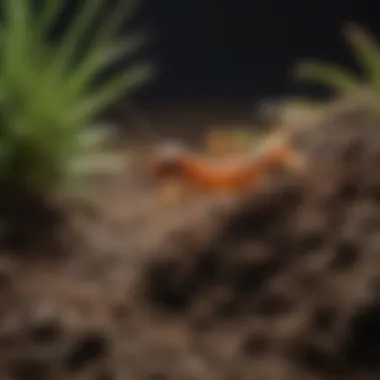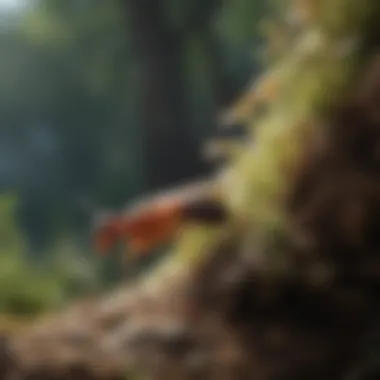Effective Strategies to Combat Fungus Gnats in Soil


Intro
Fungus gnats can be quite a thorn in the side for any plant lover, whether you’re nurturing a lush indoor jungle or tending your vegetable patch outdoors. These notorious pests thrive in moist soil, where they lay eggs, and their larvae can wreak havoc on plant roots. This common occurrence not only causes stress for plants but also affects their overall health and vitality. By grasping the lifecycle of fungus gnats, gardeners can take charge by implementing effective strategies tailored to keep these nuisances at bay.
A clear understanding of their behavior, along with addressing typical misconceptions, can empower gardeners to act proactively. An integrated approach that encompasses education and practical methods will be critical as we explore ways to eliminate these tiny yet troublesome pests. This prompts the need for better awareness and adoption of eco-conscious methods in pest management, particularly significant in our current climate-conscious landscape.
As we delve into practical strategies for managing these pests, we’ll highlight not just direct interventions but also preventative measures. This comprehensive guide underscores the importance of sustaining a healthy plant environment while effectively tackling fungus gnats. Let's get started with the essentials of effective prevention and eradication.
Understanding Fungus Gnats
Understanding fungus gnats is essential for anyone interested in maintaining the health of their plants. These tiny insects, often invisible to the naked eye, can wreak havoc on both indoor and outdoor gardens. Proper knowledge of their lifecycle and signs of infestation empowers gardeners to take effective action before the situation spirals out of control.
To tackle fungus gnats successfully, one must first grasp their lifecycle. This includes the stages of growth each gnat undergoes, namely egg, larva, and adult. Awareness of these stages allows for targeted intervention at specific times, significantly enhancing the chances of successful eradication.
Lifecycle of Fungus Gnats
The lifecycle of fungus gnats consists of three distinct stages: egg, larva, and adult. Each stage plays a crucial role in the overall reproductive success of these pests, and understanding this helps in forming strategies to combat them effectively.
Egg Stage
Fungus gnat eggs are laid in moist soil, typically at the surface. Each female gnat can deposit upwards of 200 eggs in a single go, which can lead to a steep increase in population if left unchecked. The main characteristic of this stage is the rapid rate at which these eggs hatch under favorable conditions, generally within a few days. This stage, though so tiny and easy to overlook, can lead to expansive infestation if you don't take notice.
The unique feature of the egg stage is its resilience; despite being so small, these eggs can survive adverse conditions for a short period. This makes preventive measures vital, such as ensuring the soil is not overly moist. Healthy soil management practices can greatly hinder the chances of gnats finding a suitable home to lay their eggs.
Larval Stage
Once the eggs hatch, the larvae emerge and begin to feed on organic matter and the roots of plants. The larval stage is remarkably destructive; larvae are tiny white, worm-like beings that can be seen wriggling around in the soil with a keen eye. They are particularly notable for their voracious appetite.
This stage is crucial for control strategies. Since larvae feed directly on roots, their presence can lead to stunted plant growth, wilting, and ultimately plant death. The beneficial aspect of targeting the larval stage is that various biological controls can be introduced, such as beneficial nematodes, which prey on larvae, to reduce their numbers effectively before they reach adulthood.
Adult Stage
The adult fungus gnat is the most recognizable phase. They emerge from the soil ready to begin the cycle all over again. Adults are about 1/8 inch long and are often seen flying around lights and plants, leading to easy identification. Their main characteristic is the pair of long, fragile wings and a slender body.
The adult stage is both an advantage and a disadvantage. While adults are easy to spot, they can quickly reproduce and reignite the cycle if not managed appropriately. The unique challenge here is that adult gnats are quite mobile, often moving around freely in search of water and fertile soil. It is crucial to use tactics such as sticky traps to capture these adults effectively before they can lay more eggs.
Identifying Fungus Gnat Infestation
Identifying a gnat infestation at an early stage can save serious trouble down the road. Awareness of specific signs indicating an infestation not only aids in detecting current problems but also in crafting long-term management strategies to prevent them.
Signs of Infestation
The most common signs of fungus gnat infestation include the appearance of adult gnats flying around the soil, particularly around houseplants. This visual indicator is often the first hint gardeners receive that something is amiss.
Another telltale sign is the presence of small black specks in the soil surface, which could be frass (gnat droppings), a clear indication of larval activity. Regular observation can help catch infestations early, preventing them from significantly impacting plant health.
Impact on Plants
Fungus gnats can have a deeply detrimental impact on plants. Their larvae damage roots, which leads to poor nutrient uptake and weak growth. The presence of these pests can also increase the risk of other soil-borne fungal diseases, as stressed plants are more prone to infections.
It’s important to be vigilant. The longer an infestation is allowed to persist, the greater the potential damage to your plants. Implementing effective control strategies, such as keeping the soil dry and regularly inspecting for signs of these pests, is imperative for maintaining garden health.
Preventing and addressing fungus gnat infestations requires both awareness and action. Being proactive can save a gardener a lot of heartache down the line.
Preventative Measures
Addressing fungus gnats is much like fixing a leaky roof; if you don’t take proactive steps, the damage can spiral upwards, leaving you frustrated and your plants in dire straits. Preventative measures play a crucial role in not only staving off these pests but also in promoting overall plant health. Failing to implement preventive techniques means risking an eventual infestation that could set you back significantly.


Soil Management Techniques
Choosing the Right Soil
Selecting an appropriate soil mix is akin to laying a solid foundation for your house; it’s essential for your plants' growth and vitality. Light, well-draining mixes that include materials like perlite or vermiculite help create an environment less hospitable to fungus gnats. These kinds of soils offer aeration and reduce the moisture retention that gnats thrive on. Notably, a sterilized potting mix not only nourishes plants but also ensures that potential pest eggs are eliminated before you even start planting.
- Benefits:
- Reduced chances of infestation due to minimal stagnant water.
- Enhanced root development, boosting plant health.
Proper Drainage
Like a good push on a swing, proper drainage gives your plants the upward momentum they need to thrive. Ensuring that pots have adequate drainage holes allows excess water to escape, creating an unfavorable climate for gnats. This step can significantly minimize the risk of standing water, which is a paradise for these pesky pests.
- Key Feature:
- Advantages/Disadvantages:
- Utilization of pots with drainage holes helps prevent over-saturation of soil.
- Offers a nearly foolproof system against overwatering but can be a drawback if your plants require higher humidity.
Watering Practices
Frequency of Watering
Knowing when to water plants is as vital as knowing when to fold a hand in poker. Overly frequent watering not only stresses plants but also creates a perfect breeding ground for fungus gnats. Implementing a watering schedule can maintain optimal soil moisture levels while deterring excessive dampness. For many plants, watering deep yet infrequently can be the magic bullet.
- Benefits:
- Unique Feature:
- Lower chances of waterlogged soil that fosters gnats.
- Encourages stronger root systems, which can withstand stresses better.
Best Practices to Avoid Overwatering
Finding the sweet spot for watering can feel like trying to balance on a tightrope. For keeping plants healthy, consider checking the top inch of soil before reaching for the watering can. This simple habit can save you from the overwatering that fungus gnats love.
- Key Characteristic:
- Advantages/Disadvantages:
- Get into the habit of feeling the soil
- Simple to implement at home; however, could potentially lead to under-watering if not properly guessed.
Environmental Control
Humidity Control
Humidity is another piece of the puzzle. While many plants come from tropical backgrounds and prefer a moisture-rich environment, excessive humidity can spell trouble. Fungus gnats thrive in damp conditions; thus, monitoring indoor humidity levels is a smart strategy. A dehumidifier can be your best buddy if you find that your indoor air tends to be on the muggy side.
- Benefits:
- Unique Feature:
- Helps create a balance between plant necessities and pest control.
- Facilitate conditions that are just right for your plants without encouraging pests.
Temperature Regulation
Just like you wouldn't want to be too hot or too cold, your plants feel the same. Fungus gnats tend to flourish in warmer environments, making temperature control vital. If it gets too hot in your space, consider using fans or even air conditioning to maintain a stable climate.
- Key Characteristic:
- Advantages/Disadvantages:


- Regularly check the indoor temperature, especially in the summer.
- Can require additional equipment during different seasons; however, it paves the way for more resilient plant growth.
Direct Intervention Techniques
When it comes to tackling the incessant problem of fungus gnats, direct intervention techniques emerge as a crucial avenue for achieving visible and immediate results. While preventative measures are critical, there are times when these pesky little nuisances have already taken root, so to speak. Here, the emphasis is on actively addressing the problem through physical, biological, and chemical means. Each method serves its purpose, often complementing each other to create a multifaceted approach toward elimination and ultimately, plant welfare.
Physical Removal Strategies
Sticky Traps
Sticky traps serve as a straightforward approach to catching adult fungus gnats before they can wreak further havoc. These traps, usually adorned with a bright color, attract the flying insects, where they become ensnared on the adhesive surface. One key characteristic is their low-tech simplicity—no complex setups or gadgets are needed, just hang them near affected plants. This feature makes them a favored choice among gardeners who want to avoid advanced methods.
The unique benefit of sticky traps lies in their ability to provide instant feedback. Once the traps are up, you can directly see whether your infestation is severe. However, while effective at reducing adult populations, they do not affect the larvae embedded in the soil. Consequently, they should be part of a broader strategy rather than a stand-alone solution.
Soil Top Dressing
Soil top dressing is another physical strategy that serves a dual purpose: improving the soil structure while combatting fungus gnats. This involves adding a layer of organic material, such as sand or gravel, on top of the existing soil. The primary characteristic of this method is the barrier it creates, making it harder for adult gnats to lay their eggs directly into the soil. This is a highly beneficial option as it not only addresses the gnats but also encourages healthier soil ecology.
In terms of unique features, top dressing with materials like sand aids in moisture control, preventing sogginess that attracts fungus gnats in the first place. Nevertheless, it does require some ongoing maintenance to ensure that the dressing remains effective and does not break down.
Biological Control Measures
Beneficial Nematodes
Beneficial nematodes are microscopic roundworms that offer a unique way to combat fungus gnats in their larval stage. Known for being natural predators, they inhabit the soil and actively seek out the larvae, ultimately disrupting their lifecycle. This approach is increasingly popular among eco-conscious gardeners because it avoids the use of harsh chemicals. Plus, it's a smart choice since these nematodes are harmless to plants and beneficial insects.
The unique characteristic of these nematodes is their ability to multiply in the soil, creating a self-sustaining solution in combating infestation. While effective, it's worth noting that they require specific conditions to thrive, such as adequate moisture and temperature, which may limit their efficacy in certain environments.
Predatory Insects
Predatory insects like the Hypoaspis miles can be fantastic allies in the war against fungus gnats. These tiny predators dwell in the soil and actively hunt down pest larvae, providing a natural form of pest management. They’re beneficial because they not only target fungus gnats but can also assist in managing other soil-based pests.
The primary appeal of utilizing predatory insects is their role in creating a balanced ecosystem in the soil, limiting reliance on chemical treatments. However, integrating them into your strategy does require a bit of knowledge about their habitat needs and life cycle; if the conditions aren't right, they might not survive long enough to make a significant impact.
Chemical Solutions
Insecticidal Soaps
Insecticidal soaps represent a great option for those who prefer quick results. These soaps work by suffocating the insects when sprayed directly on them. Their key attribute lies in their biodegradable nature, which means they are generally safe for the environment and won't linger in the soil post-application. This makes them a favorable choice among those looking for effective yet responsible pest control.
One notable feature of insecticidal soaps is their versatility; they can be used against a range of pests, thus simplifying your pest management regimen. On the downside, they require careful application to ensure coverage, and won't affect larvae residing in the soil. Therefore, while effective against adults, they should ideally be integrated with other methods.
Diatomaceous Earth
Diatomaceous earth, composed of fossilized algae, is another potent chemical solution that works on a broader scale. When applied to the soil surface, its sharp edges pierce the outer layer of gnats, effectively dehydrating them. Its key characteristic is its safety for plants and pets, provided it’s food-grade.
The compelling aspect of diatomaceous earth is that it remains effective as long as it’s dry, creating a long-lasting barrier against gnats in the soil. However, its effectiveness diminishes when it gets wet, and it may necessitate frequent reapplication in humid environments. For comprehensive management, it should be combined with other interventions to address all life stages of the fungus gnats.
By combining these intervention strategies—physical, biological, and chemical—gardeners can create a customized approach tailored to their specific needs, ensuring robust health for their plants.
Long-Term Management
Managing fungus gnats isn't about a quick fix; it’s about establishing strategies that last. In the grand scheme of pest control, long-term management creates a dynamic system to keep those pesky pests at bay while promoting thriving plants. When you integrate effective monitoring and maintenance routines along with preventative measures, you're essentially building a fortress around your plants. This approach lowers the chances of future infestations and allows you to address issues before they blow up into full-blown crises.
Long-term management encompasses both vigilance and proactive care. It’s not merely a checklist of tasks; it’s a mindset. The more consistent you are with regular inspections and healthy plant habits, the less likely you are to face severe outbreaks. Not only does this save you headaches down the road, but it fosters a healthier gardening environment overall.


Monitoring and Maintenance
Regular Soil Checks
Making it a habit to do regular soil checks can work wonders. It’s like giving a thorough physical to your plants at routine intervals rather than waiting for signs of illness. By digging in a couple of inches below the surface, you can feel for warmth or moisture levels. Warm and soggy soil is a breeding ground for fungus gnat eggs, so identifying this can stop infestations before they start. This proactive stance helps you catch problems early, which is always better than playing catch-up later.
The beauty of regular soil checks lies in their simplicity. You don’t need fancy equipment or expensive treatments; just your hands and your eyes. You can do this whenever you water, and it helps reinforce your connection to your plants. Observing the condition of the soil not only benefits pest control but also informs you about the overall health of your plants.
However, keep in mind that overzealous digging might disturb root systems. Thus, be gentle during your checks; you’re not trying to uproot anything, just keeping tabs on the soil’s condition.
Routine Pest Inspection
Routine pest inspection is another pillar of long-term management. It’s like having an early-warning system against any potential threats lurking in plain sight. For fungus gnats, that means looking closely at the soil surface and the plants themselves for any adult gnats or larvae. Just a few minutes spent checking during watering sessions can point out issues before they snowball.
What stands out about regular inspections is that they encourage familiarity with your plants. Knowing what’s normal speedily alerts you if something doesn’t feel right. This way, you're not only observing doggedly but also building an instinct about what’s happening with your plants.
The downside? Sometimes, you might not catch everything. The more you check, the more likely you are to find problems, but if you’re not consistent, issues might slip under your radar. So, set a schedule that you can realistically stick to—daily or weekly checks, whatever suits your routine best.
Integrating Preventative Strategies
Cultivating Healthy Plants
Cultivating healthy plants is like putting down a strong foundation for a house. Strong, vibrant plants are less susceptible to pest invasions, including those darn fungus gnats. Healthy plants can resist stress and recover faster if something goes awry. Start with good soil, adequate light, and proper nutrients. If plants are thriving, you're already zipping along the road to prevention.
The key characteristic of cultivating healthy plants is that it emphasizes the important relationship between the health of your plants and their ability to resist pests, creating a natural buffer. Not only does this benefit you in terms of pest control, but it also means you’ll enjoy vibrant foliage and pours-of-blooming flowers.
A unique aspect here is the impact of biological balance. When plants are healthy, they attract beneficial insects as well. These allies can help deter harmful ones like fungus gnats. However, it’s worth noting that sometimes pursuing plant health too aggressively can lead to over-fertilization, which in turn might attract pests. Strike that balance, and you’re golden.
Companion Planting
Companion planting is a fascinating strategy that often works wonders in pest management. By planting specific plants next to each other, you can create a protective layer against pests. Certain plants may repel fungus gnats or even attract beneficial insects to handle them. Marigolds, for instance, are known for their pest-repelling properties. By incorporating companion planting into your garden design, you’re not only enhancing aesthetics but reinforcing the defenses of your plants.
The key feature here is the synergy created in the garden. Plants that work well together can support each other, creating a more balanced ecosystem. This makes the garden less appealing to gnats while fostering healthier plant interactions.
However, companion planting can be a bit of a gamble. It requires knowledge about plant compatibility, and not all combinations yield favorable results. With careful research and attention, successful pairings can greatly enhance natural pest resistance.
Pest management is an ongoing journey, of sorts. In implementing these long-term strategies, you empower yourself to create an environment that nurtures plants while foiling nuisances—without warping your natural approach.
Ending
The management of fungus gnats in soil is not just a trivial matter for gardeners. It's about protecting the vitality of your plants and, ultimately, the success of your gardening endeavors. As outlined earlier, understanding the lifecycle and symptoms of these pests lays the groundwork for effective strategies. Developing an integrated approach by combining preventative measures with direct interventions creates a robust defense against these nuisances.
Implementing strategies like proper soil management, effective environmental control, and vigilant monitoring are key. Not to mention, methods such as utilizing beneficial nematodes or sticky traps can make a significant difference. These tools not only help in keeping your plants healthy but also in maintaining a balanced ecosystem in your garden.
Considerations for ongoing management:
- Remain observant even after implementing solutions.
- Adapt strategies as seasons change, since fungus gnat activity can fluctuate.
"Healthy practices lead to healthy plants." By fostering a resilient plant environment, you can minimize the risk of future infestations. Emphasizing environmentally-friendly solutions will not only ensure the well-being of your plants but also contribute positively to the ecosystem around you.
Summary of Key Points
In this article, we delved into essential strategies for combating fungus gnats that included:
- Understanding Fungus Gnats: Their lifecycle and how to identify symptoms of infestation.
- Preventative Measures: The importance of choosing the right soil, watering practices, and environmental control.
- Intervention Techniques: Methods like physical removal, biological controls, and chemical solutions that target the problem directly.
- Long-Term Management: Emphasizing continuous monitoring and the integration of preventative strategies to maintain a gnat-free environment.
With these strategies in hand, you are fortified against the challenges posed by these pesky invaders. Through consistent application, you can ensure the health and growth of your beloved plants.
Final Thoughts on Fungus Gnat Management
Managing fungus gnats is as much about preventive care as it is about direct intervention. It may seem like quite the hassle at times, but consider this: every step you take towards combating these pests contributes to a healthier plant. Focus on creating an environment that favors plant growth while discouraging gnat activity.
Take pride in the proactive steps you've learned throughout this article. Future infestations can be kept at bay with healthy growing practices. When you embrace the strategies discussed, you're not just managing a gnat problem, you're fostering a thriving garden.
In the grand landscape of gardening, think of your approach as a blend of art and science—each season brings new challenges, but knowledge and preparation pave the way for success.







